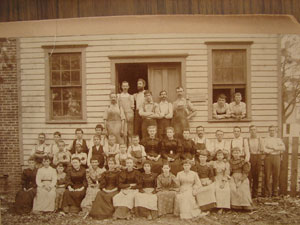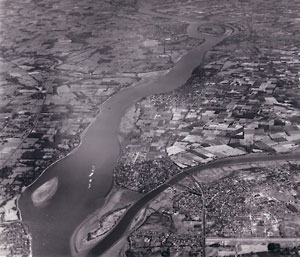Delanco, NJ | View Map

In 1910, Riverside industrialist Theophilus Zurbrugg spent $100,000 to build a large riverfront mansion on fashionable Delaware Avenue. Noted architects Furness Evans and Company designed the Georgian style house, which is listed in the National Register of Historic Places. It has been converted into housing for senior citizens. Credit: Delanco Township
This compact residential community is strategically positioned at the confluence of the Delaware River and Rancocas Creek, which has been an important waterway since prehistoric times. English Quakers began farming here in the 1670s but it remained a sparsely populated corner of Burlington County until the land boom in the mid-nineteenth century.
Delanco was formed from two separate land development ventures. In the late 1840s, local landowner Richard Wilmerton began developing a village on his farmland north of Rancocas Creek. He named his real estate venture ‘Delaranco’, presumably because of its location at the junction of Rancocas Creek and the Delaware River. Around the same time, investors formed the Delanco Land Company and sold housing lots between the Delaware River and present-day Burlington Avenue. Both Wilmerton and Delanco Land Company investors anticipated that the availability of boat and railroad connections and proximity to Philadelphia (13 miles distant) would appeal to the growing numbers of suburban homebuyers and drive up land prices.

Small businesses in the lower Delaware valley benefited from surging demand for consumer products in the last half of the nineteenth century. This Delanco factory is probably the Ridgway Shoe Factory, which began with three employees in 1881. By 1907, the company produced more than 350,000 pairs of shoes for children and infants each year. Credit: Burlington County Library
When the land development boom began here, regular steamboat service operated on the Delaware and Rancocas Creek and Camden & Amboy trains stopped at the small Rancocas Creek junction. Early morning market trains from the Rancocas stop to Philadelphia began regular service in the 1840s. The new rail connection helped sustain local farms because shipments of food and livestock could reach the city the same day. A wharf on the Rancocas served smaller steam packets traveling to and from Mount Holly and around 1850 a new Delaware River wharf was built for the village. By 1880, the small village had 150 homes and a population of 450.

In the 1890s, Methodists began holding multi-day religious revivals known as camp meetings at Fletcher’s Grove in Delanco. The site was in use until the 1960s. Credit: Cardcow.com
In 1861, village residents watched experimental naval technology unfold in Rancocas Creek. With the help of a daring local crew, a French inventor tested a strange new “diving” boat just offshore. Shortly after the U.S. Navy in Philadelphia discovered the new submersible, they ordered a full-scale version to use against Confederate ironclad boats in the Civil War. The Alligator was the first submarine built for the U.S. Navy. It was designed primarily to launch divers who could plant explosives under ships or perform underwater operations.
Although the C & A built a railroad bridge over the Rancocas between Delanco and Riverside in 1832, the nearest wagon and passenger bridge was five miles away at Bridgeboro. There was no other bridge connecting the towns until 1870. The Riverside-Delanco Bridge, which opened in 1935, is the third in this location. The 160-foot center span rotates to accommodate boat traffic.

In this 1929 photo, Hawk Island is visible at the confluence of the Delaware and Rancocas Creek. Over the next sixty years dredging deposits will transform it into a sandy peninsula. Burlington County is working with Delanco and nonprofits to create a 20-mile greenway along Rancocas Creek. Credit: Hagley Museum and Library, Dallin Aerial Photo Collection
Delanco has a total area of 3.4 square miles, which includes nearly one square mile of water. Hawk Island, a 118-acre uninhabited peninsula at the township’s southwestern corner, is the result of manmade and natural forces. The Delaware is periodically dredged to maintain the deep navigation channel needed by large cargo ships and dredging spoils have been deposited here since the 1930s. The former island is now many times its original size.
The village became known officially as Delanco when a post office was established here in 1857. Delanco was part of Beverly Township until 1926, when residents petitioned the State legislature to create Delanco Township.
For more information:
- www.delancotownship.com
- www.burlingtoncountyhistoricalsociety.org
- www.navyandmarine.org/alligator
- www.co.burlington.nj.us
- www.rancocasconservancy.org
- www.njtransit.com
Banner art: An engraving of the diving ship Alligator, the first submarine built for the U.S.Navy. The prototype was just four feet wide and powered by oars. Credit: www.navsource.org/archives






